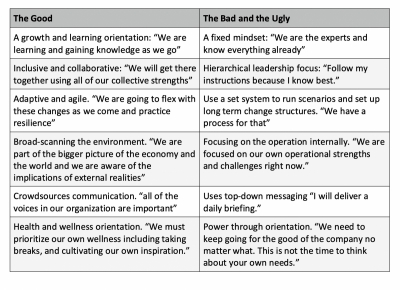It is in the most stressful moments that leaders are most important. In a crisis like the current COVID-19 pandemic, others look to their leaders for answers, for a calm mind and a strong perspective. They want to hear they’re part of something larger than themselves, that you have their back, that we’re all for one and one for all, and that we will help each other get through the crisis and potentially become stronger for it. We need inspiring leadership in these times, to ground people in what’s important and reduce fear.
Our organizations, both large and small, face the need to adapt to rapid change that is not predictable or even controllable. People who lead and manage are hit with a new level of complexity in decision-making, time management, and simple focus. A 2019 Gartner survey of 2,800 business leaders found that only half believe they are “well-equipped to lead their organization into the future.”
So how have our leaders responded so far during the COVID-19 crisis? Let’s take a look:
The Good
Think of the leaders who are standing out during the COVID-19 pandemic. New Zealand Prime Minister Jacinda Ardern and New York Governor Andrew Cuomo are two leaders who have been garnering attention for their calm, steadfast, and empathic approach to leading in a crisis. In fact, worldwide, both of these leaders have a large following outside of their respective jurisdictions as people seek leadership during this moment of crisis. Each of them has their own unique style, but there are some clear similarities:
1. “Keep Calm, Carry on” messaging. Both Ardern and Cuomo are taking the shock value out of their communication by presenting facts, telling brief stories that demonstrate empathy, and asking their constituents consistently in every communication to be patient and kind with each other.
2. A “Safety First” Focus. Both Ardern and Cuomo have referred to their economic and health struggles from the perspective of safety and security—addressing people from that lowest level of Maslow’s hierarchy of needs—survival.
3. Humanizing Moments. Cuomo has joked via video chat with his then-quarantined CNN journalist brother, Chris, and told stories about his mother. Ardern has gone on Facebook Live after putting her child to bed and told the children of New Zealand that the Easter Bunny is, indeed, an essential worker and will not be kept home.
4. Acknowledging Challenges. Both Ardern and Cuomo have acknowledged the damage their respective shutdowns will do to their economies, but their messages are clear—we will address this health crisis as a road to addressing the economic one.
5. Highlighting Collaboration. Ardern and Cuomo both have built coalitions with health experts, heads of state, business community leaders, and others to a) view the crisis from multiple angles and b) create solutions through collaborative effort.
On the commercial stage, just look at the many organizations that have asked, “How can we contribute during a global crisis?” and shifted their factories to making masks and personal protective equipment for healthcare workers. They range from car interior manufacturer Zettl Group (which typically supply Rolls Royce and Porsche with high-end leather seating) to Hanes and Los Angeles apparel companies that are all filling a gap for healthcare workers using their existing equipment and insights from the healthcare industry. This innovation was possible because they asked the question: How can we contribute?
The Bad and The Ugly
On the other end of the spectrum, leaders with a fixed mindset—a view of reality that is not focused on growth or change, but rather, is static—are the ones who fare worst during a global crisis.
Some organizations have misjudged the situation and are in danger of coming out of the crisis with a tarnished reputation. Amazon’s standing is wavering as stories come out about not providing employees with protective gear or enough space and lack of transparency about exposure to the virus.
Online fashion retailer ASOS has been accused of “playing Russian roulette with people’s lives” as it refused to enforce social distancing in its warehouses, where up to 4,000 people work.
Airlines and holiday companies also are coming under fire as some refuse to engage with customers who want their money back on canceled trips. Easyjet’s CEO, Johan Lundgren, appealed to the UK government to provide it with a loan to prevent the business from going bankrupt, yet still planned to pay shareholders dividends of £170 million (U.S.$211,861) the same week.
Here is a summary of the attitudes that have made for effective and ineffective leadership during COVID-19:

The Coronavirus pandemic has heralded a new era of uncertainty in the whole of society, and this requires a new standard of leadership. Those leaders who can move beyond fear and who have the ability to look at the big societal picture are the ones who will come out of our current global crisis in a positive place.
Karlin Sloan is a global leadership and development coach; CEO of Sloan Group International; and author of the new book, “Inspiring Leadership for Uncertain Times.”

